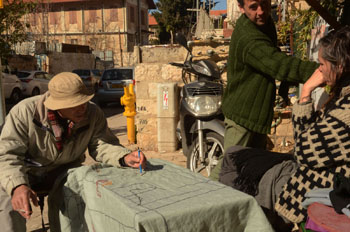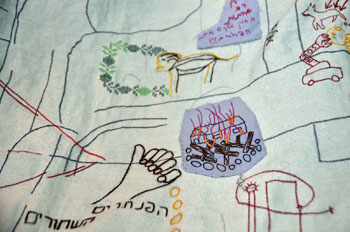Musrara is a neighborhood placed
in the center of Jerusalem where three different communities, Palestinian,
Israeli and Ortodox Jew live in their distinct areas. Though the neighborhood
is so small that it could be circled on foot in 15 to 20 minutes and borders
between those communities communities are comprised in simple street crossings,
very few of local inhabitants would head for this route, and if they happen
to, it will most probably be charged by certain tensions.
Reason for this could probably be explained with in particular complex
history of the place, parts of which we grasped during our month and a
half long stay and embroidering with people of Musrara.
The neighborhood came into existence when during more stable period of
the Ottoman Empire by the late XIXc. the wealthier Christian Palestinian
Arabs dared to settle outside of the fortified city walls. They were one
of the first communities to do so.
In the first part of the XXc. under British Colonial jurisdiction while
the City of Jerusalem is extending in all directions Musrara becomes its
administrative center. A number of institutions settle there so as numerous
religious compounds of different political powers at the time (Russian,
Italian, Bulgarian, French, etc), who desired to have their feet on the
Holy Land.
As a result of 1948 Israeli-Jordan war (Nakba) sets the border right over
Musrara and until 1967 neighborhood will entirely remain in the 'no mans
land' between the Isreal and Jordan. Local inhabitants, wealthier Palestinian
population was forced to leave their well constructed houses, New Israeli
Government who administrated the 'no mans land' declaring them 'abandoned
propriety'.
Successively the Zionist plan of creating jewish state, being in need
for more population included organised transits of oriental jews to Israel.
IIWW alies greatly supported this operation, as a post war reparation
programe for the damage made to the jewish community during the war.
But the Mizrahi jews from Marocco, Algieres, Tunis, etc. arrived only
couple of years after the Ashkenazi (european jews) already 'occupied'
and divided all the 'abandoned' proprieties. They were given to live in
determinate areas, and had no given equal rights and living conditions.
In the same way one group of Mizrahies was assigned to inhabit evacuated
luxury chalets of Musrara's no-mans land in the early 1950's. But big
villas now were fragmented in small housing units where in one room a
numerous family was put to live. Apart from that intentional neglect by
Israeli Governmet, general bad conditions, lack of assistance, access
to education and information, so as constant exposition to the bullets
from the jordanian border patrol, left the community to cope with its
own living, pushing the young generations to deliquesce and criminalization.
The 1967 war brings changes where Israel through 6 days war operations
'saws' the 'ripped parts' together and adhering the totality of Jerusalem
to its juridiction, referring to the until then border as a 'simm line'.
Israeli governance over Jerusalem is instituted de facto through the rule
of force, though it was not recognised by the International community.
For living in Musrara it means a big changes: suddenly from the periphery
it returns to be in the center of the city. Its 'uneducated and savage'
inhabitants that were consistently marginalised, neglected, filling their
purpose of 'clay pigions' to the Jordanian border, now all at the sudden
they were occupying the luxiory villas in the historic center of the city.
But in the same time young generations of Mizrahies are also getting more
informed and they are becoming concious of the rol their families played
in realization of the Zionist agenda. An Israeli Black Panthers movement,
spread precisely from that neighborhood..
Nowadays...

